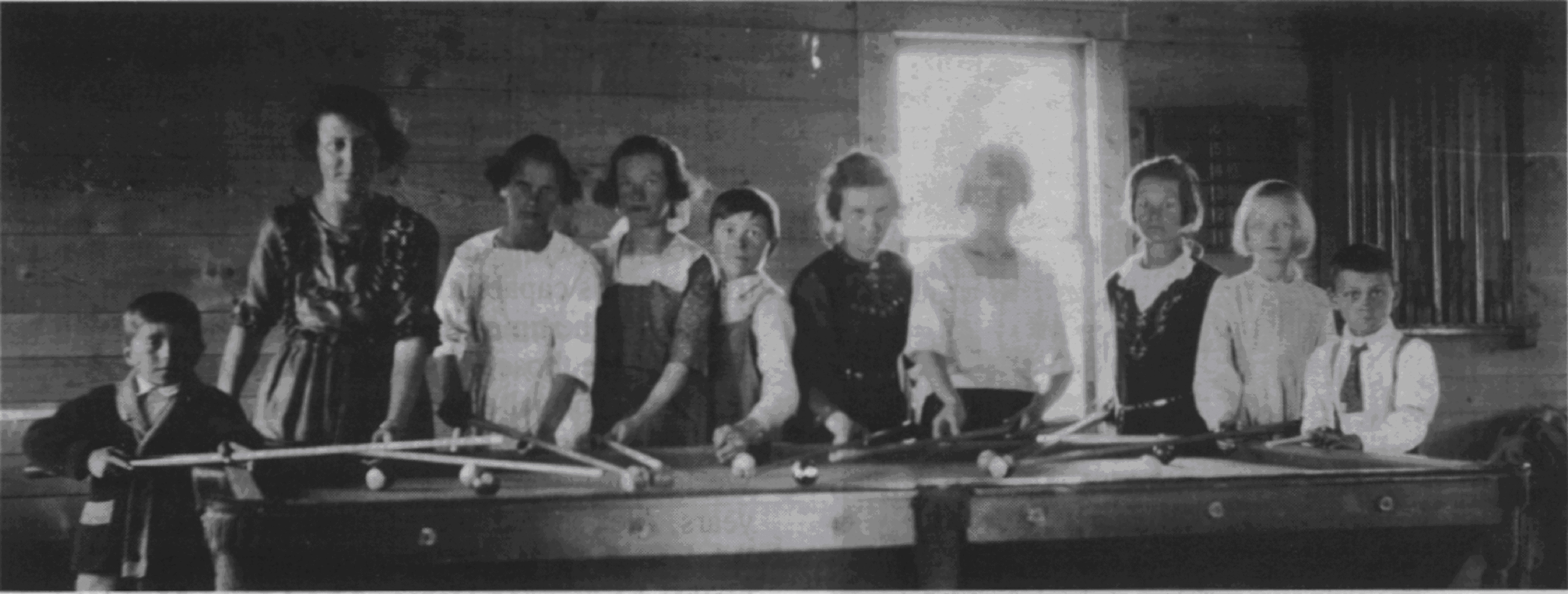













|
Nick and Erena Woronuk |

The coming of the steel was a major turning point in the lives of many early settlers, including the Woronuk family. Jobs on railway gangs became available and provided families with desperately needed cash.
A market was now available for whatever produce the pioneer farmers could afford to sell and the long awaited access to Edmonton became a reality. Another benefit of the railway was the establishment of a store at Rycroft's siding by Gerry Knezovich and Rukavina. A new school SD# 2109 was constructed on the present school site in 1918. As the railway progressed westward and then branched off southward to Grande Prairie, it sliced through grandfather George Woronuk's homestead (later Nick Woronuk's) river lot #39. On the Southern segment of this divided quarter the small hamlet of Rycroft started to take shape about 1922 or 1923. During this era, the McEwen brothers surveyed the Rycroft town site. The present Rycroft Hotel was constructed. Doc Calkin once again moved his store (for the last time) from the now aborted Spirit River Centre to the corner lot opposite the hotel. Alex Lewchenko and Nick Woronuk established a pool hall and a sizeable tract of land consisting of several acres was sold by Nick Woronuk to the Spirit River Agricultural Society. Thus, the matrix of the Rycroft Community was cast. As the hamlet grew, Mr. Hamlins' land was subdivided on the west and later further subdivision took place on the east on the Woronuk land.
The Agricultural Society Grounds and Rycroft became a focal point in the Peace Country for such activities as the agricultural fairs and the Rycroft Stampede with cowboys participating from all over Alberta including Calgary and points in the United States. The Burnt River King, owned by Mike Markovich, reigned supreme and refused to be ridden by the best cowboys in the west for several years. Various types of rodeo events were staged. Bert Sales, Jim Hanna, and Nick Markovich were key figures in organizing the stampedes. During the first week in August, the very interesting and highly competitive North-South Baseball Tournament was held, with All-Star players from all parts of the Peace participating. All these activities were good publicity for the community. Rycroft was very much on the map.
For the early settlers and especially the Woronuk family, close proximity and ready access to Rycroft was a distinct advantage. Nevertheless, this historical occurrence was not beneficial to Nick and Erena in every respect. River Lot #39, an excellent farming quarter and one of only two homesteads they acquired, was badly fragmented and almost completely taken out of agriculture. There was little demand for lots in the Rycroft subdivision in the early days with the result that any revenues received from lot sales were quickly consumed by taxes and levies. Lot prices were therefore reduced far below value and literally given away. Ownership of such a subdivision today would undoubtedly be a valuable asset.
Endurance, perseverance, hard work and later a ready market and higher prices for farm produce with the arrival of the steel, were factors that were responsible for the transition from the days of the oxen to the horse and buggy days. Along with this change, came a sudden change in social conditions. Regular passenger service together with the appearance of the Eaton's catalogue in every home was akin to the emergence of a large nearby shopping centre today. The enormous improvement in the economy, communications and hence the standard of living could perhaps best be described as "The Post War Boom" or "The Boom of the Twenties". During this period three more sons were born: Alex, March 13, 1920; Merose, May 18, 1922; and John, November 18, 1928.
In 1924, Nick Lazoruk and Nick Woronuk jointly purchased a Case steam engine and threshing machine which they used to harvest many crops in the area. It became economically feasible for Nick and Erena to acquire one more quarter of land, (NW quarter of Section 15, Township 78, Range 5, West of the 6th Meridian), a herd of cattle, several horses and to develop large flocks of various types of poultry. This was a period of prosperity for them. Hence, the decision to construct a beautiful Aladdin home in 1929, which even to this day is a lovely land mark. They hired Mr. Wherrell, an English mason, to erect the building; he did an outstanding job.
The economic crash of the dirty Thirties came suddenly. The effects of the depression on the Woronuks was not as severe as they were on many people because by then they were reasonably well established. A substantial portion of the homestead land had been cleared and cropped, the livestock herds and poultry flocks and five large gardens developed. Bill, the second oldest son, who showed the most promise as a farmer was withdrawn from school and asked to help look after the farm. With Bill's help, Nick and Erena were able to assist the other four sons in completing their education.
During the Hungry 30's economic conditions were indeed difficult; receiving 25-30 cents a bushel for wheat and breaking even or taking a loss for shipping cattle to Edmonton definitely hurt but not nearly as much as that first year on the homestead. After learning to live off the land, a lesson in survival, indeed, the adjustment to the poor economic situation of the depression was not such a difficult adaptation with all the farm garden produce, they had to sustain them.
Page 1
|